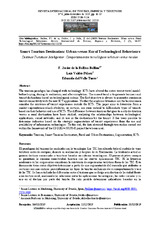Mostrar el registro sencillo del ítem
Smart Tourism Destination: Urban versus Rural Technological Behaviours
| dc.contributor.author | Del Valle Tuero, Eduardo | |
| dc.contributor.author | Ballina Ballina, Francisco Javier de la | es_ES |
| dc.contributor.author | Valdés Pélaez, Luis | es_ES |
| dc.date.accessioned | 2020-01-09T09:45:58Z | |
| dc.date.available | 2020-01-09T09:45:58Z | |
| dc.date.issued | 2019 | |
| dc.identifier.issn | 2530-7134 | |
| dc.identifier.uri | http://hdl.handle.net/10396/19255 | |
| dc.description.abstract | The tourism paradigm has changed with technology. ICTs have altered the entire tourist travel model: before buying, during its realization, and after completion. The current trend is to generate business and tourist destinations based on technological criteria. The first objective is always to guarantee maximum tourist connectivity with the new ICT applications. Neither the academic literature nor the businessmen consider the existence of tourist experiences outside the ICTs. This paper aims to determine from a market segmentation which attributes, or services, are more critical to differentiate types of tourists based on their behavior and use of ICTs. The differences between tourism that goes to a city destination versus a rural destination have been studied, analyzing the relationships between technological applications, social networks, and its use in the destination by the tourist. It has been possible to determine indicators based on the strategic segmentation of tourist experiences from the use and availability of information technologies. To this end, the data obtained through two studies carried out within the framework of the CSO2014-59193-R project have been used. | es_ES |
| dc.description.abstract | El paradigma del turismo ha cambiado con la tecnología. Las TIC han alterado todo el modelo de viaje turístico: antes de comprar, durante su realización y después de su finalización. La tendencia actual es generar destinos comerciales y turísticos basados en criterios tecnológicos. El primer objetivo siempre es garantizar la máxima conectividad turística con las nuevas aplicaciones TIC. Ni la literatura académica ni los empresarios consideran la existencia de experiencias turísticas fuera de las TIC. Este documento tiene como objetivo determinar a partir de una segmentación del mercado qué atributos o servicios son más críticos para diferenciar los tipos de turistas en función de su comportamiento y uso de las TIC. Se han estudiado las diferencias entre el turismo que se dirige a un destino de la ciudad frente a un destino rural, analizando las relaciones entre las aplicaciones tecnológicas, las redes sociales y su uso en el destino por parte del turista. Ha sido posible determinar indicadores basados en la segmentación estratégica de las experiencias turísticas a partir del uso y la disponibilidad de tecnologías de la información. Para este fin, se han utilizado los datos obtenidos a través de dos estudios realizados en el marco del proyecto CSO2014-59193-R. | es_ES |
| dc.format.mimetype | application/pdf | es_ES |
| dc.language.iso | eng | es_ES |
| dc.publisher | UCOPress | es_ES |
| dc.rights | https://creativecommons.org/licenses/by-nc/4.0/ | es_ES |
| dc.source | Revista Internacional de Turismo, Empresa y Territorio (RITUREM) 3(2),16-37 (2019) | es_ES |
| dc.subject | Tourism | es_ES |
| dc.subject | Smart Tourism Destination | es_ES |
| dc.subject | Rural and Urban Destinations | es_ES |
| dc.subject | Segmentation | es_ES |
| dc.subject | ICTs | es_ES |
| dc.subject | Turismo | es_ES |
| dc.subject | Destinos Turísticos Inteligentes | es_ES |
| dc.subject | Destinos Urbanos y Rurales | es_ES |
| dc.subject | Segmentación | es_ES |
| dc.subject | TICs | es_ES |
| dc.title | Smart Tourism Destination: Urban versus Rural Technological Behaviours | es_ES |
| dc.title.alternative | Destinos Turísticos Inteligentes: Comportamientos tecnológicos urbanos versus rurales | es_ES |
| dc.type | info:eu-repo/semantics/article | es_ES |
| dc.relation.publisherversion | http://www.uco.es/ucopress/ojs/index.php/riturem/index | es_ES |
| dc.rights.accessRights | info:eu-repo/semantics/openAccess | es_ES |

